October 14 - 20, 2018: Issue 379
A Visit To Bungan Castle By ABHS
John shared stories of his uncle, Adolph Wilhelm Albers, how Bungan was one of our original Artists Colonies - literally everyone who was anyone in Australian Art during the 1910's through to 1930's stayed there, and how John has plans to renew the castle as an Artists' mecca.
Clearly there is a lot more to share here and John will allow us to delve deeper with him as his project to renew and return Artists to Bungan Castle draws closer - with plans to launch the venture in 2019 - one hundred years after that wonderful landmark atop Bungan Head was first ready to throw open its doors to the best creatives and wordsmiths in Australia.
In fact there will probably be more on that and Bungan, Mr. Albers/Alvers and the Webecks before that - we hope!
Geoff Searl presented John and Pauline with a copy of his great new book 'Times Past' as a thank you on behalf of ABHS.
Below run some of the many articles from earlier times that have granted insights into Bungan Castle and Mr. Albers, a passionate campaigner for Australian Artists, and below these, the way Bungan Castle looks today, in the Spring of 2018.
And hopefully among them another 'thank you' in some form for John - thank you John - wonderful!
John's uncle, Adolph. W. Albers, by B E Minns, Dec, 1920 - just one of the pages in the Bungan Castle 'Visitor's Book'
John's uncle, Adolph. W. Albers, by Norman Lindsay in the Bungan Castle 'Visitor's Book' - who didn't visit the castle one may ask!
Adolph. W. Albers - born March 9, 1879, in Hanover - passed away in Sydney in 1959 aged 80 (St Leonards registration)
Pauline and John Webeck
ABHS Members and their host John.
Bungan Castle & Adolph Wilhelm Albers: From The Pages Of The Past
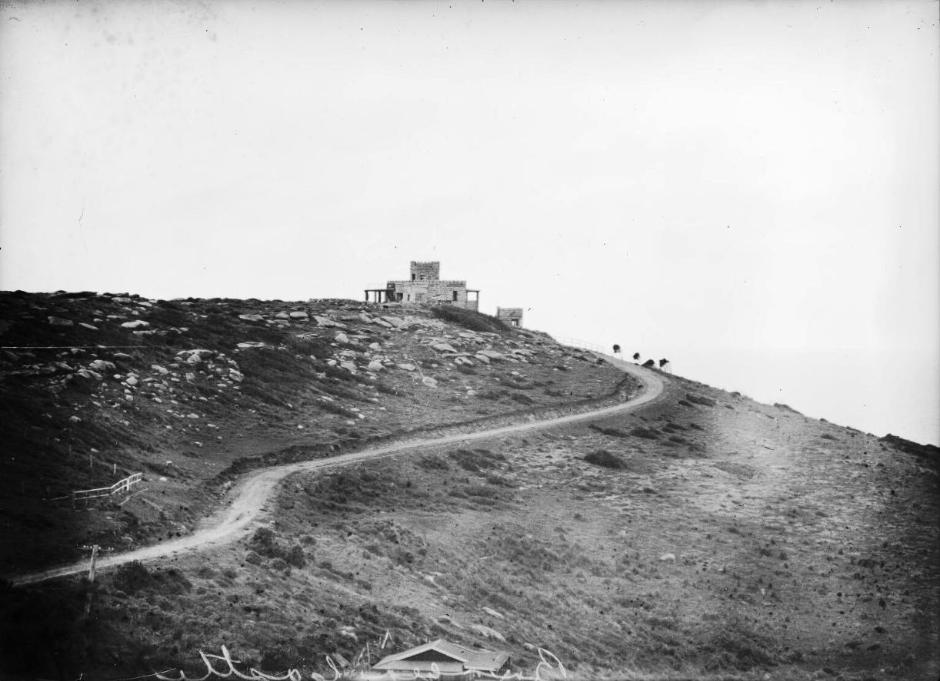
Road winding up to Bungan Head Castle, Newport, Sydney, ca. 1928, PIC/15611/16753 LOC Cold store PIC/15611 Fairfax archive of glass plate negatives, courtesy National Library of Australia
Commenced in 1916, and completed by 1919/1920, this landmark along our coast remains a feature of Bungan Beach. Early articles speak of the historic pieces of colonial history that have been gathered as so many gave 'relics' found to be housed at Bungan Castle. John Webeck explained after some of these appeared that people simply started giving 'stuff' to the family and Bungan Castle became an unofficial repository for many articles and could be deemed Pittwater's first museum:
Castle Turrets on Sydney's Skyline
Nobody Wants them
Our Baronial Halls
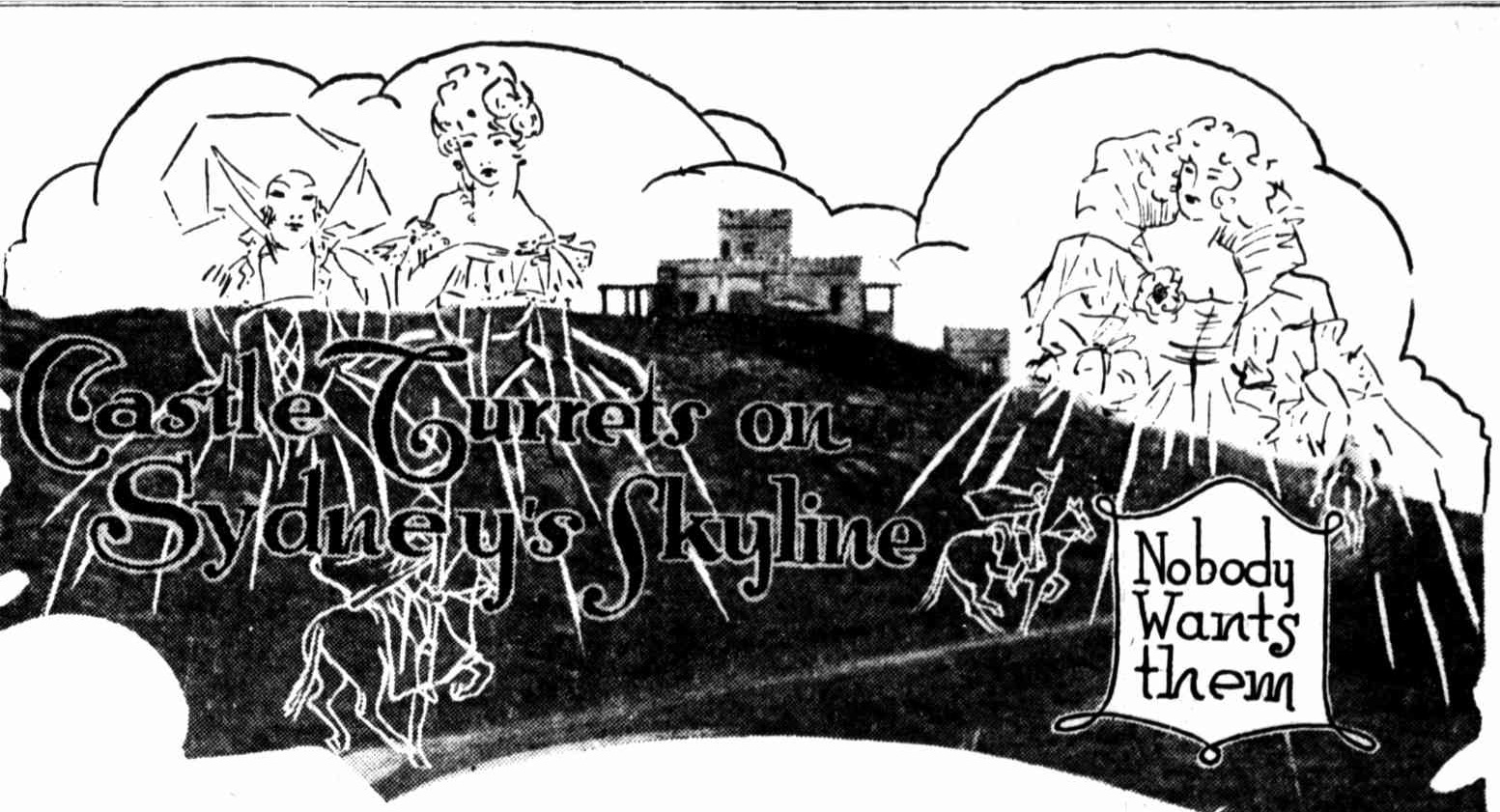
Do you know Sydney's crumbling castles? Yes — Sydney, young as it is. Their turrets burst through the mass of red tiles which ever way you look. This article describes them.
What offers for this genuine stone castle, complete with donjon, battlements, towers and turrets, official ghost, dungeon, vaults, battle-axes, skeletons, and fish-pond? There is a dreadful silence. Come, come. Are we bid four-pence? We are not bid fourpence. Doesn't anybody, want this castle? It's a good castle. It's got ivy growing round the portcullis, and a coat of arms over the front door. It's got a stone courtyard, and a number of fine old danksome crypts, and a collection of authentic gargoyles. Any advance on fourpence? Nothing moves in the old castle. There is no noise but the crumbling of plaster, the flapping of wallpaper, the far-off trickle of buried water. Sunlight yellows the old empty rooms. The air is dead, stirred by no cur-rent, heavy with the odor of decay. The world goes on outside, Sydney looks over the fence, a million people live their lives, in semi-det. brick bungs., but nobody wants a castle. That is the sad fact. The castle business has fallen on bad days. The bottom has tumbled out of the baronial Industry. Nobody wants a castle in 1927.
Gone are the days when a retired prince of commerce yearned to be set up in an ancestral mansion, with battlements and drawbridges, and a herd of coach-men with cockades in their hats. Like huge, forgotten relics, the bones of dinosaurs, you will find their sentimental traces over Sydney. These are the castles of 1870. But the retired prince of commerce in 1927 prefers comfort to romance. He would sooner have a Californian villa with billiard-rooms and built-in cupboards and electric refrigerators. Castles give him a pain. And so we find them scattered over Sydney to-day — huge, melancholy derelicts, with crumbling walls and silent corridors. Nobody wants them. Nobody looks at them. They are just castles, and there is no advance on fourpence.
But wait! There is one glorious exception. Bungan Castle. Motoring round the coast from Manly, you see its incredible turret against the sky-line, in between Pittwater and Newport, over Bungan Beach. It is built on the very pinnacle of the cliff. Its lonely tower looks down over a sheer precipice into the foaming Pacific.
There are no houses near it. It stands there, solitary and desolate, a castle from some Rhenish crag. And it is a real castle. That is to say, it is conducted as a castle should be. No "To Let" notices have been plastered on its gates. Its owner evidently has a feeling for castles. A Sydney art dealer is the proprietor. The place looks immemorial, but it has really only been built about seven or eight years. The whole thing has been constructed out of stone taken from the spot itself. If you venture up the long, lonely winding road, into the hall, you might think, for one astounding moment, that you had suddenly walked back three centuries into the enchanted kingdom of Queen Elizabeth. The walls inside are rugged stone. Windows open on to the stormy sea. And on the battered oak table a great candelabra of silver has been drip-ping its wax.
All round, suspended from the walls, an extraordinary collection of medieval armor, helmets, weapons, swords and daggers, completes the picture. From the ceiling a stuffed hawk dangles. Ships' lanterns hang by its side. Racks of muskets are in every corner. Over the enormous stone fireplace, piled up with real baronial logs, are Saracen helmets, Viking shields, pistols, and battle-axes, also an unpleasant medieval weapon consisting of two iron spikes on a chain.
The bedroom, opening off this big hall, is equally magnificent. The stone walls are draped with tapes-tries. A candelabra is fixed to the bedstead, and underneath this a knife rests in an engraved sheath. On the table there is a gong, and a rope, swinging on the wall, connects with a big bell up on the roof, which may be tolled at appropriate moments. The big bell itself has a history. It is called the "Execution Bell," and it came from Wiseman's Ferry, where it was rung every time a convict was put to death.
Sea-chests and rapiers, convict leg-irons, pistols and swords and old oil paintings are everywhere. There is a rusty bayonet which was fished up from the Tank Stream. There is a shark's jaw from Aden, and a rifle from the Zulu campaign. A jovial touch is supplied by a fat barrel, with a silver spigot, standing in one corner.
Over the door in the hall a human skull is set. It was found on Bungan beach, washed up in the surf. Up in the turret-room, at the top of the tower, there is another skull, this one from the South Sea Islands.
Farther down the coast, in the village of Manly itself, hemmed in bed red tiles and suburban back-yards, another castle rears its towers into the air. This is called Dalley's castle. Its masonry is perfect, even to the coat of arms chiselled over the gate. The grounds have long since been sub-divided or drowned in weeds. Here and there broken statues, ends of terraces, fragments of urns and pillars, protrude from the earth. There is a magnificent stone stairway guarded by a pair of arrogant carved lions. But, alas! the castle is for sale.
And nobody seems anxious to live in a castle. In the old courtyard the carriage used by Lord Loftus rests. Its wheels are missing, and it is thick with dust, but an air of vice-regal dignity still hovers round the venerable relic. In the centre of the courtyard there is a gas-lamp-post. You can imagine what the scene was like on a dark winter's night, with carriages clattering over the cobble-stones, grooms coming out of lighted rooms, and the old lamp-post shedding its watery radiance on the steaming horses. Well, there you are. If you want a castle, you can have It. Or you can have half-a-dozen others — immense stone buildings, gloomy with dark dignity, scattered over the older suburbs of the city — regions like Strathfield, which 60 years ago were still suitable for country houses. The ex-Speaker, Mr. Willis, lives in a splendid castle at Middle Harbor. Seen from the water, with its turrets floating, above the tree-tops, it seems incredibly magnificent. But even Mr. Willis is dissatisfied with his castle. He says it is too cold in the winter. There's no doubt about it. Castles are unfashionable. Battlements and donjons have retreated in favor of tennis-courts and wireless-masts. Meanwhile, if you've got enough to run it, you could probably have a perfectly good castle given to you.
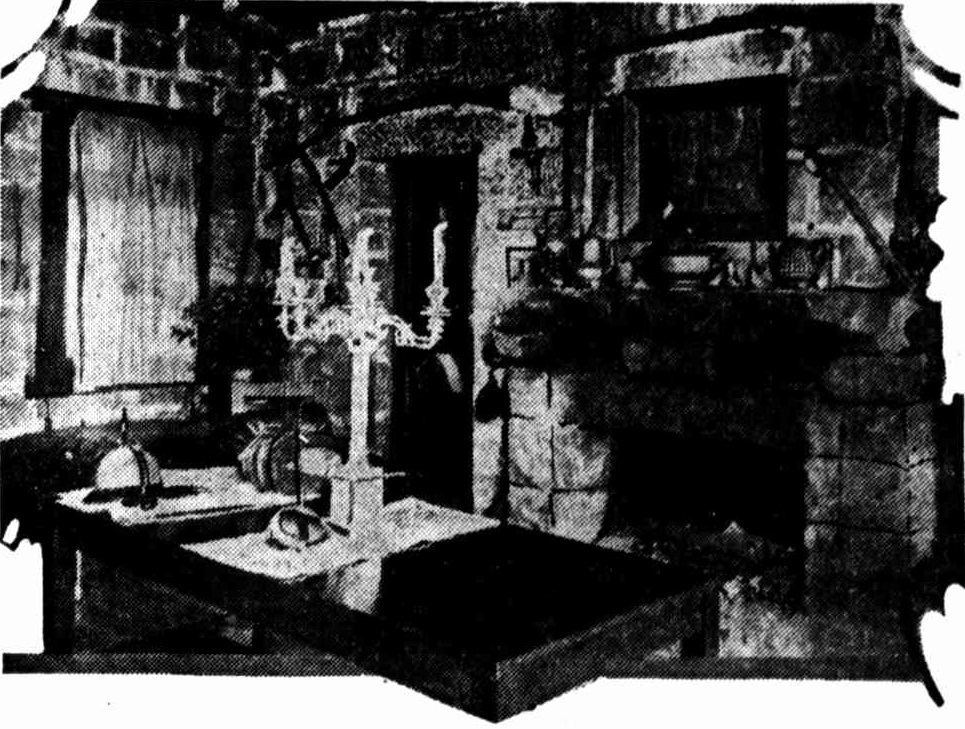
The atmosphere of age — the main hall in Bungan Castle. Notice the stuffed hawk swinging from the rafters.
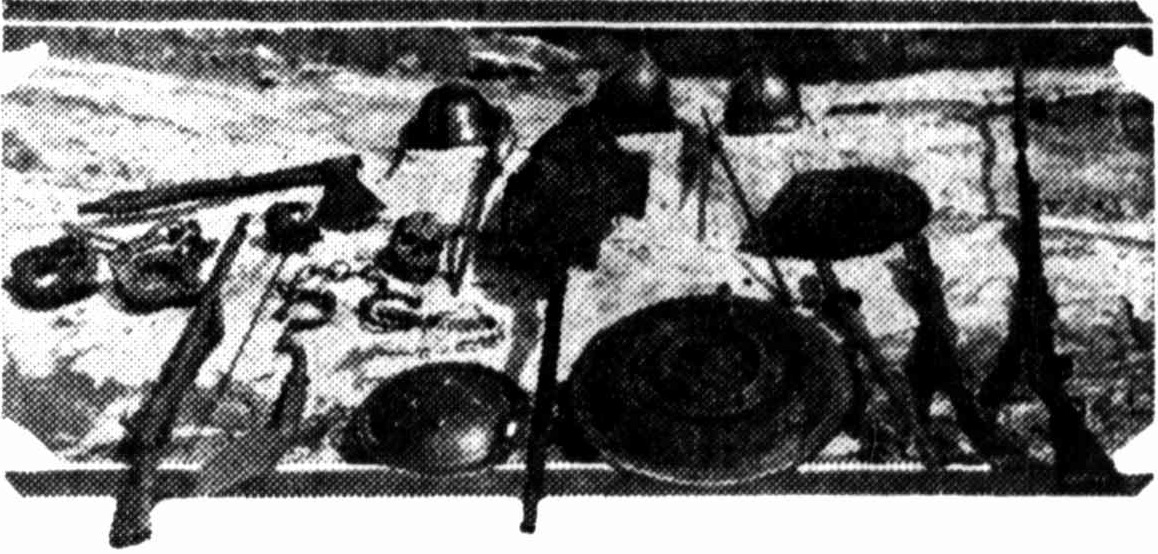
Baronial accessories from Bungan. They include a skull washed up in the surf, a Viking shield, a Saracen helmet, a set of convict leg-irons, and a Scotch battle-axe which is said to have beheaded Wallace.
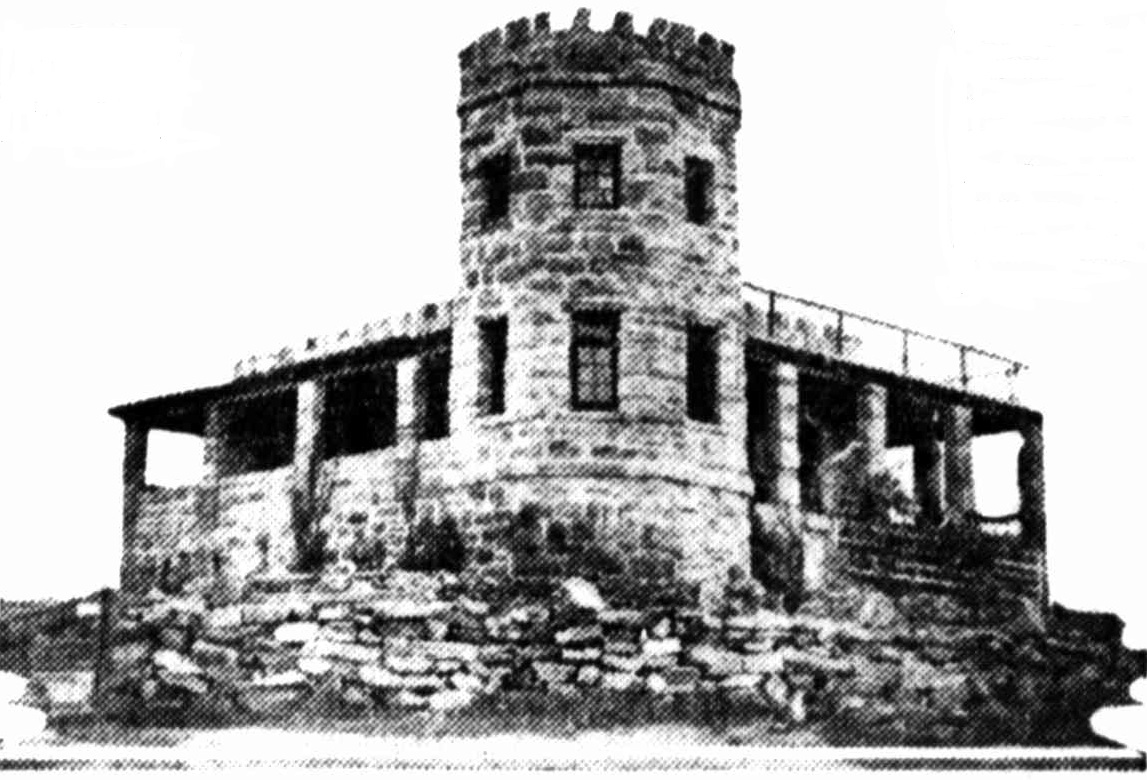
Bungan Castle. It looks medieval, but it has only been built seven or eight years.
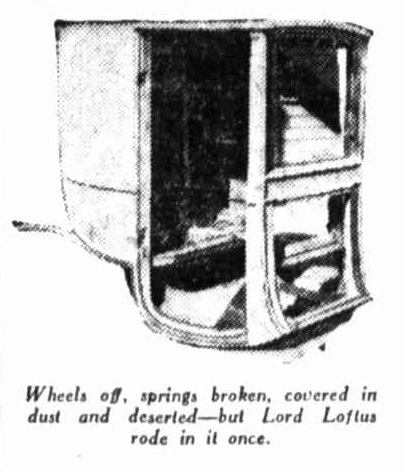
Wheels off, springs broken, covered in dust and deserted — but Lord Loftus rode in it once.
Castle Turrets on Sydney's Skyline (1927, May 8). The Sun (Sydney, NSW : 1910 - 1954), p. 29. Retrieved from http://nla.gov.au/nla.news-article223623550
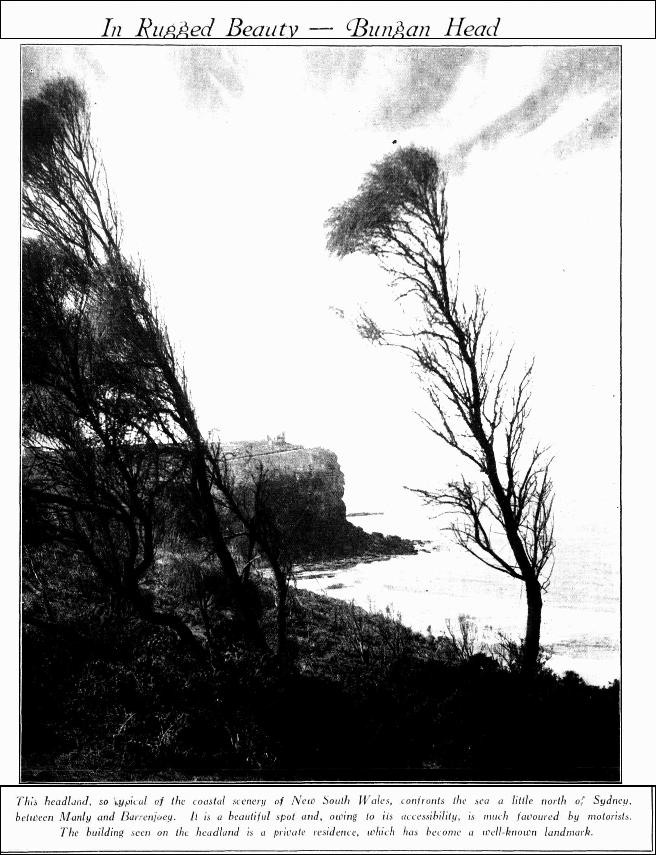
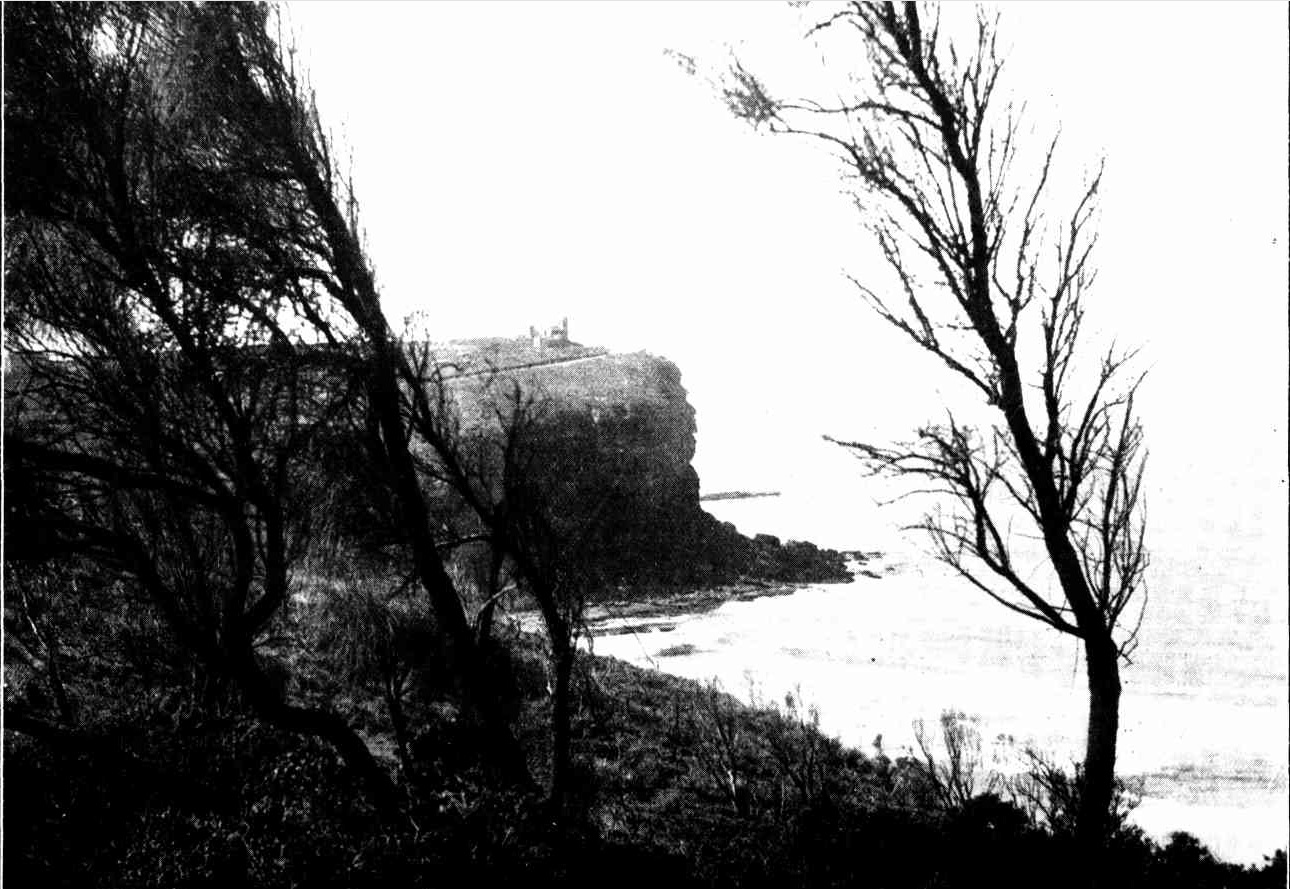
In Rugged Beauty — Bungan Head
This headland, so typical of the coastal scenery of New South Whales, confronts the sea a little north of Sydney, between Manly and Barrenjoey. It is a beautiful spot and, owing to its accessibility, is much favoured by motorists. The building seen on the headland is a private residence, which has become a well-known landmark. In Rugged Beauty — Bungan Head (1933, September 20). Sydney Mail (NSW : 1912 - 1938), p. 5. Retrieved from http://nla.gov.au/nla.news-article165961885
A POTATO FREAK. This extraordinary tuber was dug up recently at Bungan Castle, Newport, near Sydney, by Miss Aleathea Albers. No title. (1936, June 17). Sydney Mail (NSW : 1912 - 1938), p. 43. Retrieved from http://nla.gov.au/nla.news-article160639873
MUMMIFIED CAT.
Puzzle for Customs.
STRANGE SPECIMEN'S ARRIVAL.
Listed among the possessions of Mr. G. H. Stelling, of London, who arrived in Sydney by the Jervis Bay this week, Customs officers were puzzled to find an item : "One dead cat." Their amazement was even greater when they saw the cat.
It was perfectly preserved mummy, but its snarling face indicated a death in agony.
In a Staffordshire castle, 30 years ago, the cat was discovered, wedged between the skirting board and the wall. Its tortured face told of a terrible struggle to escape the disastrous ending to what doubtless began as a high-hearted mousing expedition. Inquiries showed that the room had not been entered for 90 years. Water, possibly impregnated with minerals from the wall, had dripped on to the body, apparently assisting to preserve it. The skin has hardened almost until it is like bone, and the wrinkles in the neck are still perfectly modelled.
Mr. Adolph Albers, of Sydney, saw the specimen in Mr. Stelling's study in London some years ago, and admired it. As Mr. Stelling's wife objected to its macabre appearance, he determined to bring it to Sydney with him and present it to Mr. Albers.
"FREE FROM DISEASE."
The facts of the case were explained to the Customs officers, but this was no simple import. Tariff schedules were searched. Was it a "work of art?'" Inquiries failed to discover a precedent. The officers decided that the cat could not be admitted until it was certified by the stock quarantine authorities as free from disease.
Eventually, after inspection by the State stock inspector, it was declared a healthy dead cat, and allowed to enter. Mr. Albers took delivery yesterday.
It will join other specimens, including a skull found in underground Paris, in Mr. Albers's home, Bungan Castle, Newport.
"I am fascinated by it," said Mr. Albers yesterday. "I think it will be the same in another 120 years' time."
(Picture on illustrations page.) MUMMIFIED CAT. (1936, November 20). The Sydney Morning Herald (NSW : 1842 - 1954), p. 9. Retrieved from http://nla.gov.au/nla.news-article17290810
A Castle Fronts The Sea
By M. FLYNN
While travelling along the Pacific Coast highway from Sydney recently we felt suddenly that our eyes were deceiving us.
There on Newport Head stood an old Norman Castle, complete with towers and castellated walls, as though mysteriously transported from Britain or old France. However, a closer approach showed the castle to be undoubtedly real. A small sign stated that we could inspect it and we promptly did so, curious to learn its history, which, briefly, is as follows: In 1916 an artists' representative, Mr. A. W. Alvers, of Sydney, widely travelled in older lands, decided to build himself a weekend castle, on the then deserted Newport Head, modelling it after old fortresses he had seen. It was solidly built of the local stone, and friends and soldiers helped in its building.
Completed In 1918
In 1918 it was completed and sat firmly on the headland many hundreds of feet above the blue Pacific rolling below the steep cliffs. From the windows of its round tower rooms one may see magnificent views along the coast-north to Avalon; south to Narrabeen and Collaroy, with Long Reef stretching its talons into the blue; and east to the immensity of the Pacific.
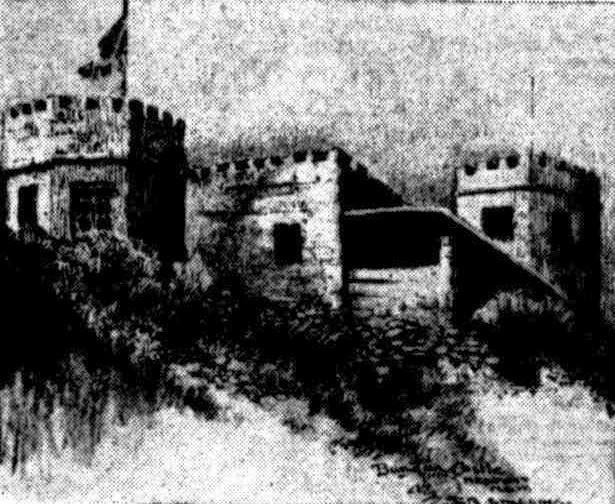
Bangan Castle, Newport, N.S.W. From a drawing by F. R. Stelling
The rooms of the castle are filled to overflowing with treasures and curios collected from all over the world. The skull of a long-dead French sailor jostles that of an aboriginal. A Malay kriss rests side by side with an old flint-lock gun. Ancient ships' lamps hang in every room and window. A tom-tom(relic of the Portuguese-Timor war) stands beside a pair of 80 year-old Russian samovars. The headpiece and chain-mail of a 15th Century Knight of Malta rests by the head of a Balinese woman carved cunningly in wood.
"Rare And Profitable"
It is a veritable museum of things "rare and profitable" ancient pewter, old French silver candlesticks, English china of a past age of elegance, Japanese enamels, and sad relics of the old convict days. The castle stands proudly on the sheer ridge of Newport Head, though settlement has crept up on its rear and the coast highway sweeps past its entrance. Mr. Alvers, its builder, growing old now, still lives there with a faithful Great Dane for company, in his fortress home that has no terrible memories of war or dungeons, but which expresses instead an enduring solidity, grandeur and peace. Life and Letters. (1953, May 16). The West Australian (Perth, WA : 1879 - 1954), p. 30. Retrieved from http://nla.gov.au/nla.news-article55804281
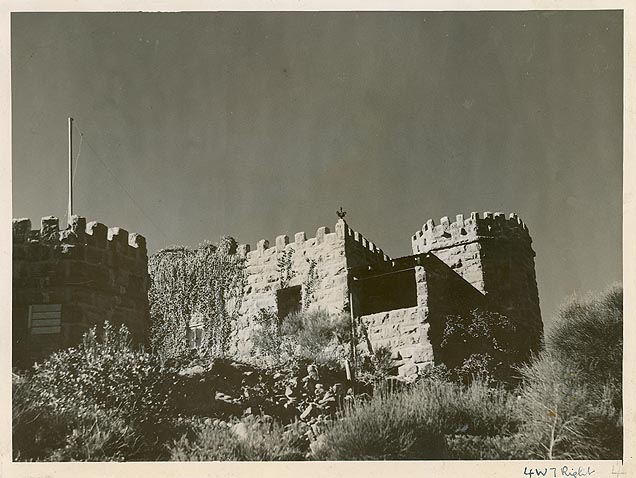
"The Castle", Bungan Head (NSW) Image No.: 12932-a012-a012X2442000144, from 'Original Prints of Photographs used in NSW trains', courtesy NSW Archives and records
SHIRE OF WARRINGAH.—Naming of Roads.—Ordinance 30, Clause 53, Local Government Act.—Notice is hereby given that the undermentioned roads have been renamed in accordance with section 249 (a) of the Local Government Act:—
Past Name or Location—New Name.
1. Road connecting Prescott-avenue with Bix-road, Dee Why—Wigan-street. (The above proposed name supersedes an earlier proposal to name this street Narree-street.)
2. French's Forest road, French's Forest:— (a) From Wakehurst Parkway easterly to its junction with Warringah-road—French's Forest road East.
(b) From Wakehurst Parkway westerly to the eastern boundary of portion 1,134 (the point at which road closure commences)—French's Forest road West.
(c) Between Rabbett-street and Forest-way—Naree-road. (d) Between Grace-avenue and Prince Charles road— Sorlie-road.
3. Beaconsfield-street East, Newport, between Barrenjoeyroad to Myola-road—Bungan Head road.
J. MORGAN, Shire Clerk, Shire Hall, Brookvale, 25th November, 1957. 1787—£1 11s. 6d. SHIRE OF WARRINGAH.—NAMING OF ROADS.—Ordinance (1957, November 29). Government Gazette of the State of New South Wales (Sydney, NSW : 1901 - 2001), p. 3859. Retrieved from http://nla.gov.au/nla.news-article220359872
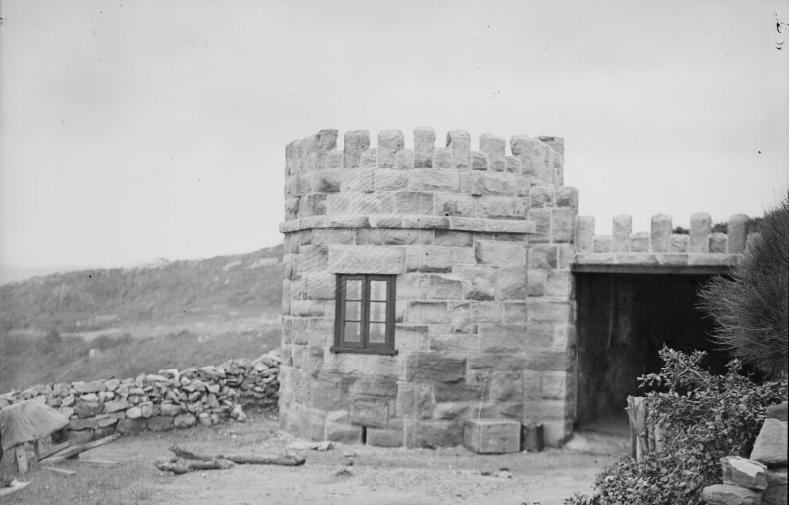
Bungan Castle turret exterior, New South Wales, ca. 1920 PIC/15611/3515 LOC Cold store PIC/15611 Fairfax archive of glass plate negatives - courtesy National Library of Australia
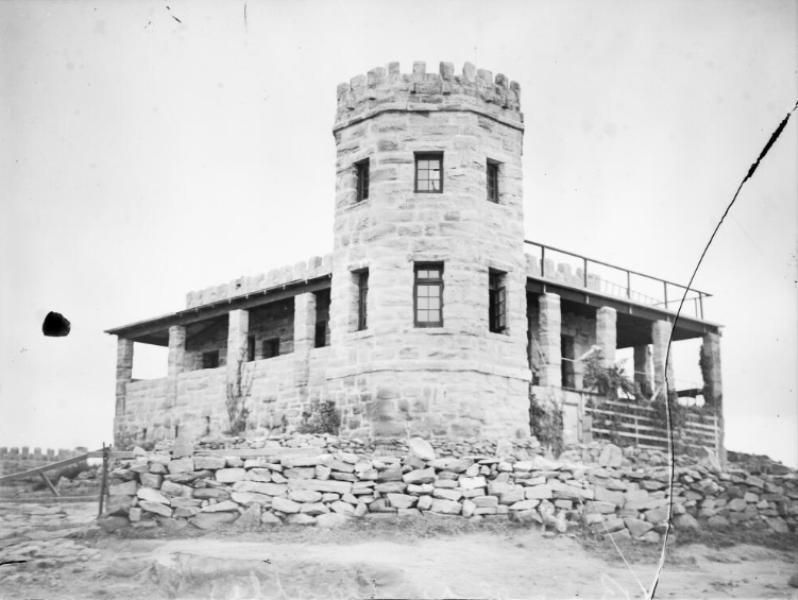
Bungan Castle on Bungan Head, Newport, New South Wales, ca. 1930 - PIC/15611/11599 LOC Cold store PIC/15611 Fairfax archive of glass plate negatives - courtesy National Library of Australia
CASTLE ON A CLIFF EDGE.
(BY. W. E. M. ABBOTT)
Many years ago— just after World War I., to be exact— a well-known Sydney artist and connoisseur dreamed a dream. Maybe, though he had lived in Australia almost all his life, his thoughts turned back to his native Alsace Lorraine and nostalgic memories of the wooded country sweeping down to the River Moselle, with the vineyards of this favored spot surrounding many a grey battlemented fortress and castle-legacy of the old Middle Kingdom of Charlemagne’s grandson,- Lothaire, from whom Lorraine took its name.
Memory can play us many a strange trick — give us sudden urges to recapture the past—or create something from the past to incorporate in our present everyday life. Who knows what it was that caused the artist to suddenly decide he would build a castle —not of dreams, but of solid sandstone, to defy and withstand –the passage of the years. And so, on a bold headland of the coast, about eighteen miles from Sydney, rose-a sturdy battlemented building with its tall, octagonal tower that can be, seen as a landmark all along the coast as one motors from Manly to Palm Beach. Isolated amid a setting of dull green coastal trees, stunted by the winds sweeping in from the sea, boldly silhouetted against the skyline, with the Pacific thundering at the foot of the cliffs on which it stands, and with its stout walls fretted by the . gusty winds that blow almost continuously, it presents a striking picture. No headland in England carries a more rugged looking tower, no medieval fortress in Italy stands squarer to the four winds of Heaven.
Contrasting with the austerity of the stone walls in the terraced garden rioting about the castle —a profusion of multi-colored geranium and gay flowers, making a contrast against the azure blue of the sea, the flashing white of seagulls' wings, and the green of pine trees, and glossy leafed hedges. The owner, with a keen eye to all that is lovely and unusual, has furnished : his castle in, Keeping with its .'aged outside ' appearance; so that only lately, has he permitted such an innovation as electricity to oust the candles in their heavy silver, candelabra that shed, their glow on stoned walls of the great central living room, lighting up grim pieces of armour, old battle axes and swords —and the rich color of oil paintings, throwing into bold relief the great smoke-stained , yawning chimney place, and shedding pools of light on the heavy slabbed oaken central table. A skull grins down from the high stone wall between two candle scobs. Old and yellowed, it seems harmless enough — not even an object of fear to my small daughter as she holds it in her hands, gazing into the empty eye sockets as if she would wrest the past from its sightless cavities. Just as well she cannot, for long ago this was the head of a famous murderer who paid the penalty for his crimes upon the scaffold.
More pleasant, and less macabre subject for speculation, is the heavily tooled, handsome, leather covered visitors' book, looking like some ancient tome from the library of a Monastic Brotherhood. Inside its stout covers one realises it is indeed a record of a brotherhood not monastic, but artistic, for here are the signatures, quips and jests of a host of artists and literary folk, whose names are household words in Australia, and also beyond our shores. Many of the artists' pictures have been painted on the very coastline the castle dominates.
Many, together with men of letters, have been guests beneath the stout roof tree, sleeping in the turret room opening direct into the battlements, towards which eager ivy which mantles the walls, climbs year after year. Rare books, old silver and pewter, jostle cheeks with quaint glassware, and oil paintings sombre and gay. The ground floor room in the tower, with its deep set windows, is lined with cedar, and shelves carry a load of books, indicating pleasant leisure hours.
Many people who have never been within miles of the castle are familiar with it from the story strip in the 'Sydney Morning Herald,' featuring the Conways—for Thunder Castle, at Thunder Head, is the fictitious, but artistically accurate prototype of Bungan Castle, on Bungan Bungan Head which John Roland and Betty Santry have created for the 'Conway family' in their daily pictorial serial— even Sheba, barking defiance at strangers from the battlements, or collanaded verandah, appears as the Conways dog. In an area of cement sheet and wooden week-enders— one is grateful to an artist who many years ago dreamed a dream, and out of it rose the stout walls and grey tower of 'The Castle,' known to all residents of Newport Beach as a familiar and pleasing sight, dominating the headland above the seaside village.CASTLE ON A CLIFF EDGE. (1949, March 25). The Scone Advocate (NSW : 1887 - 1954), p. 6. Retrieved from http://nla.gov.au/nla.news-article162719685
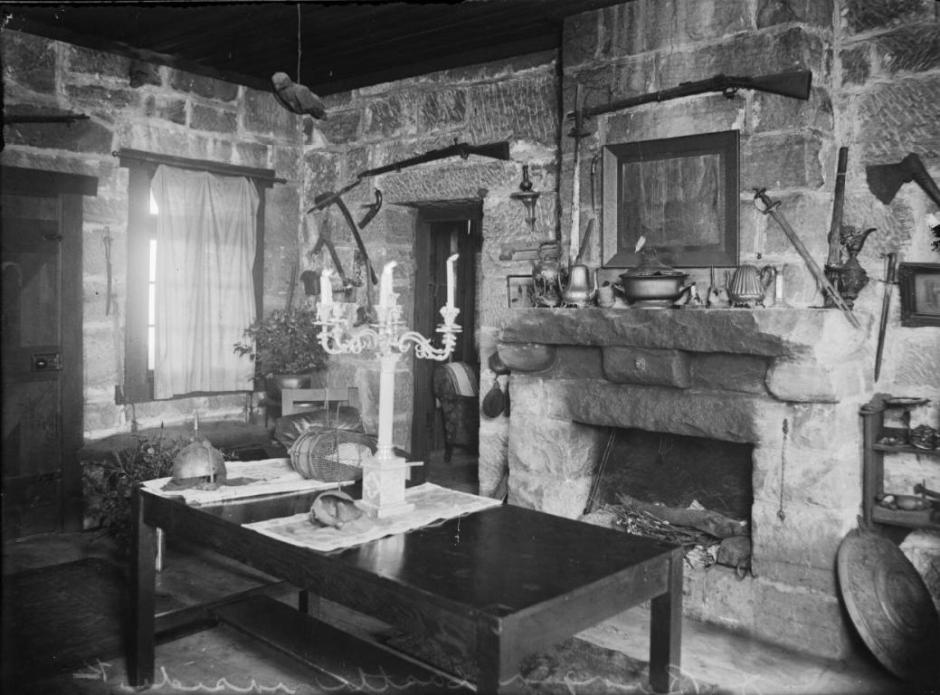
Historical artifacts decorating a room in Bungan Head Castle, Newport, Sydney, ca. 1928 - PIC/15611/16720 LOC Cold store PIC/15611 Fairfax archive of glass plate negatives
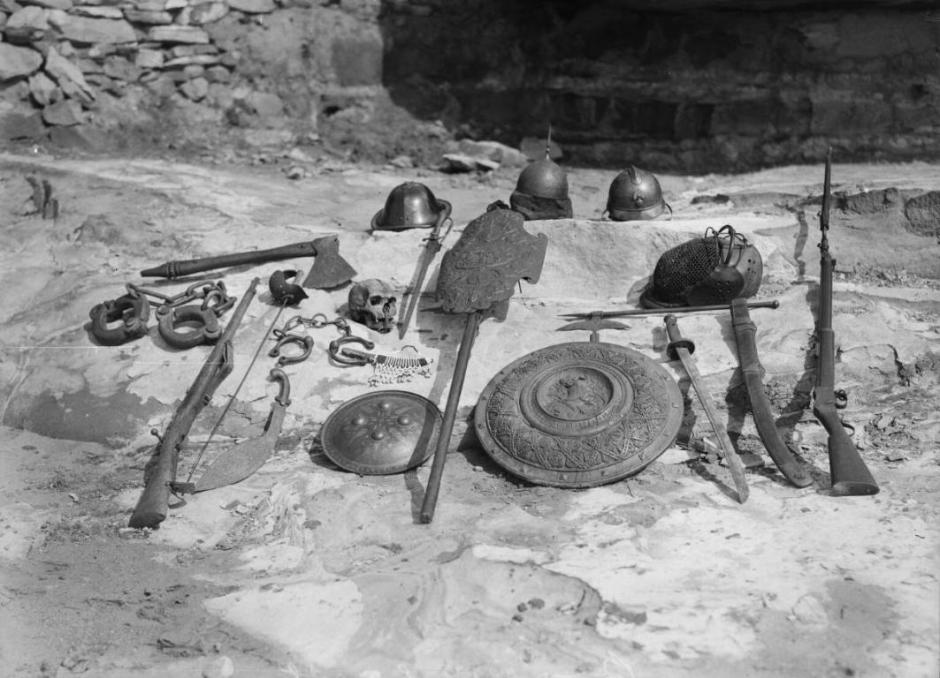
Gustav Adolph Wilhelm (William In English) Albers 1879 - 1959
Marriage: 10477/1901 ALBERS GUSTAV A W MACURER FRIEDA WOOLLAHRA - [MEURER]
Two daughters - Elsa, born 1905, and Althea, born 1908, mother Frieda Sophia born 1877, birth registered at Paddington (parents Otto and Anna). Frieda passed away in 1957.
ALBERS.—August 16, 1908, at her residence, Sutherland-street, Paddington, the wife of Adolf W. Albers— a daughter. Family Notices (1908, August 26). The Sydney Morning Herald (NSW : 1842 - 1954), p. 8. Retrieved from http://nla.gov.au/nla.news-article14984379
STOLEN PAINTINGS.
A THIEF IN BOND-STREET.
By night Bond-street is one of the most solitary by-streets of the city, and yesterday morning an artist's representative, Adolf W. Albers, arrived at his showroom in building No. 11 to find £98 worth of unframed pictures missing.
Fourteen pictures in oils, water colours, and black and white had been picked up indiscriminately from a baize-covered side-table, and they included works by Messrs. Sid Long, Lister Lister, Gilbert Holiday, Cyrus Cuneo, J. J. Hilder, Garvanui, Grant, and Sidney Cox.
The showroom is situated at the top of two dark flights of narrow stairs. There are two entrances below, and it is thought that one of these was left open by someone on Saturday. When Mr. Albers turned his Yale key in the door at 10 a m. yesterday he could not open it, as the bottom bolt, which is never fastened in the ordinary course of events, was holding the door. It was some time before he was able to effect an entrance. He then discovered a confused heap of pictures on the carpet, and a large Australian water colour in a frame was lying away from the easel on which it had previously stood. STOLEN PAINTINGS. (1913, July 1). The Sydney Morning Herald (NSW : 1842 - 1954), p. 13. Retrieved from http://nla.gov.au/nla.news-article15432082
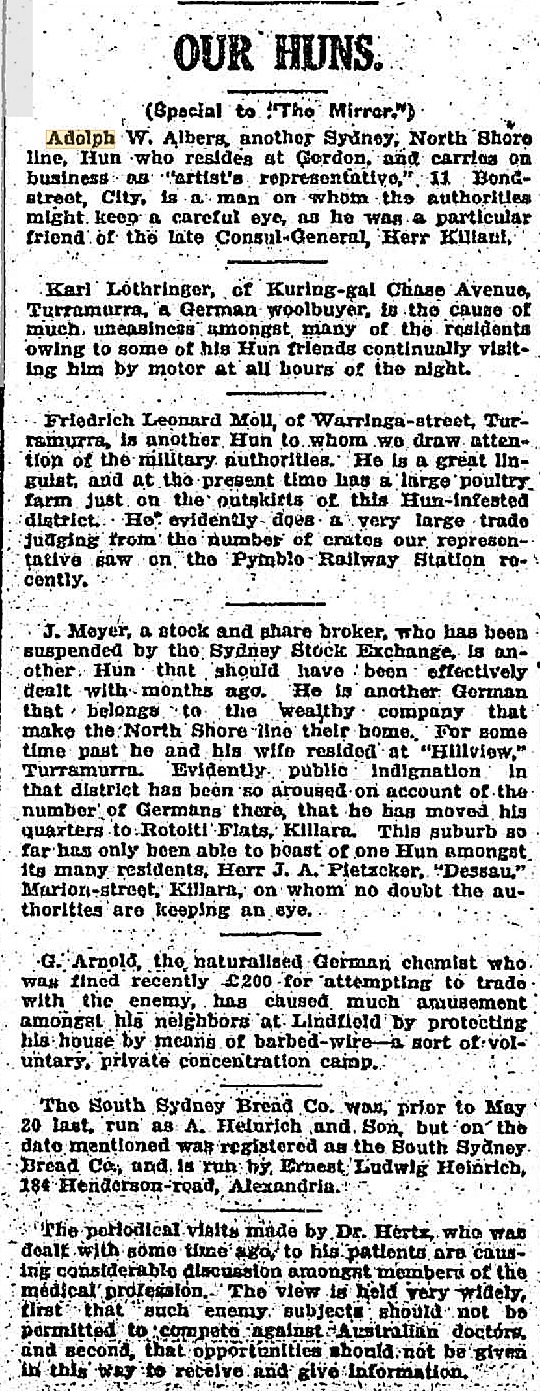
OUR HUNS. (1915, December 4). The Mirror of Australia (Sydney, NSW : 1915 - 1917), p. 3. Retrieved from http://nla.gov.au/nla.news-article104645583
A FERRY ACCIDENT.
£10,000 DAMAGES CLAIMED. Sydney, June 12.
Acting on behalf of Alathea Agnes Albers (13), of Gordon, Adolph William Albert, her father, today caused to be issued a Supreme Court writ claiming £10,000 damages from the Sydney Ferries, Ltd., in respect to injuries received while she was a passenger on the steamer Kuramia, on the occasion of the public schools boat race. In consequence of the accident Miss Albers lost a leg, which was ampntated In an hospital. A FERRY ACCIDENT. (1923, June 13). The Advertiser (Adelaide, SA : 1889 - 1931), p. 10. Retrieved from http://nla.gov.au/nla.news-article37184402
A £10,000 WRIT.
Acting on behalf of Alathea Agnes Albers, a minor, by her next friend, Adolph William Albers, Mr. W. H. Drew, solicitor, has issued a writ out of the Supreme Court, claiming £10,000 damages from the Sydney Ferries, Ltd., in connection with injuries received by the girl in an accident which occurred while a passenger on the steamer Kuramia on the occasion of the great public schools' boat race on the Parramatta River. A £10,000 WRIT. (1923, June 15). Macleay Argus (Kempsey, NSW : 1885 - 1907; 1909 - 1910; 1912 - 1913; 1915 - 1916; 1918 - 1954), p. 4. Retrieved from http://nla.gov.au/nla.news-article234211346
ALL SCHOOLS' REGATTA
Girl Loses Leg £10,000 CLAIM SETTLED
On May 5 last at tho All Schools' Regatta, Althea Albers, of Gordon, was a passenger on tho ferry steamer Kuramia and in consequence of a collision with the Gladesville bridge her leg was injured and subsequently amputated.
Her father, Adolph William Albers, art dealer, Gordon, then issued a writ against the Sydney Ferries, Ltd., alleging negligence as his daughter's next friend in law. Miss Albers was then 14 years of age.
The case was settled In No. 2. Jury Court this afternoon before Mr. Justice Gordon.
Mr. A. R. J. Watt, Mr. Pitt, and Mr. H. V. Evatt (Instructed by Mr W. H. Drew) appeared for plaintiff, and Mr. R. C. Broomfield, K.C., Mr. Harry Stephen, and Mr Braddon (instructed by Messrs Norton, Smith and Co.) for the defendant company. The terms of settlement were not disclosed.
ALL SCHOOLS' REGATTA (1923, September 19). The Sun (Sydney, NSW : 1910 - 1954), p. 9 (FINAL EXTRA). Retrieved from http://nla.gov.au/nla.news-article222689798
MEURER. — February 1, 1927, at her residence, 112 Sutherland-street, Paddington, Anna Katharina, beloved wife of O. Meurer, aged 84 years. Family Notices (1927, February 2). The Sydney Morning Herald (NSW : 1842 - 1954), p. 14. Retrieved from http://nla.gov.au/nla.news-article16351986
MEURER. - The Relatives and Friends of Mr. OTTO MEURER, OTTO and Henry, Mr. and Mrs. ADOLPH ALVERS and FAMILY, Mrs. M. MEURER and FAMILY, and Mr. A. MEURER, are kindly invited to to attend the funeral of his dearly beloved WIFE, their MOTHER, and their GRANDMOTHER, Anna Katharina Meurer; to leave Kirby and Son, Ltd.. Private Mortuary Chapel, 265 Elizabeth Street, city, THIS WEDNESDAY, at 2 p.m. for the Lutheran Cemetery, Rookwood. Motor Funeral by road. Family Notices (1927, February 2). The Sydney Morning Herald (NSW : 1842 - 1954), p. 13. Retrieved from http://nla.gov.au/nla.news-article16351909
JAVANESE BRASS INDUSTRY.
INTERESTING EXAMPLES.
Mr. Adolph W. Albers returned by the Nieuw Holland yesterday after a two months' tour of Java, which he had visited with the object ot investigating the native brass industry in all Its phases. Mr. Albers gave it as his opinion that the work done by the native craftsmen showed that the Javanese brassware was easily the most solid and the finest in execution that could be seen anywhere In the world. "Usually," said Mr. Albers, "the metalwork of Indian and Chinese artists is quoted as being the richest in design, but that is not truly the case. I found that the brass prepared by the original native methods, which have been in vogue for perhaps hundreds and thousands of years, is superior to all others by reason of the fact that it is rich in copper and zinc, with but a modicum of lead."
It was pointed out by Mr. Albers that unfortunately there was a tendency for this very old native industry to become commercialised and on that account to lose much of its artistic value. As in all other expositions of art he had found that among the native artists there existed the true artist, as well as the "pot-boiler." One fact specially to be noted was the entire absence of machinery, the whole of the many operations being carried out along lines that had been followed by the craftsmen for centuries.
With respect to the designing of brass objects, Mr. Albers also directed attention to the fact that the design was engraved direct from the graver's tools without the slightest attempt having been made at a primary drawing.
Mr. Albers has brought back with him a fine collection of high-class native brass ornaments, which he secured for several wellknown private art collectors in Sydney. JAVANESE BRASS INDUSTRY. (1929, November 7). The Sydney Morning Herald (NSW : 1842 - 1954), p. 15. Retrieved from http://nla.gov.au/nla.news-article16599593
TO THE EDITOR OF THE HERALD.
Sir, - In regard to Mr. Noel G. Harvey's letter, my scheme to Mr. Scullin does not deal in any way with the issue of a stamp to commemorate any one event. Least of all the Easter Show. It is of much greater importance, in fact, not less than a complete issue of new stamps, ranging from 1/2d to £1, for each State of the Commonwealth. In addition to that, certain stamps could be published from time to time to commemorate very noticeable events of historical nature. By a new issue of stamps of each State, the monotony of our present stamps would be removed, and will give business houses a chance to tell at a glance where their com-munication came from. On my recent trips abroad I was often asked by eminent Philatelists in various countries if Australia was going to sleep on the issues that have been in existence for a great number of years.
I am, etc.,
ADOLPH W. ALBERS.
July 17.
TO THE EDITOR OF THE HERALD. (1930, July 18). The Sydney Morning Herald (NSW : 1842 - 1954), p. 9. Retrieved from http://nla.gov.au/nla.news-article16698732
KINGSFORD SMITH'S COMMEMORATIVE STAMP.
TO THE EDITOR OF THE HERALD.
Sir,-In reference to Mr. Stephen Lowe's letter, as to the criticism of the design of these stamps and his mention of my name in connection therewith, I wish it to be clearly understood that, while Mr. Lowe's contention that I was the promoter of the idea is correct, I am in no way responsible for the design of the stamps.
I heartily endorse Mr. Lowe's criticism In regard to the artistic design, and it is to be regretted that even the poor quality of the paper, as well as the printing, is open to severe censure. When it is considered that these stamps are likely to reach every corner of the world, It is a pity that so little pride and interest by the authorities has been taken in tile Issues.
I also beg to mention the adverse opinion expressed in the "Sydney Morning Herald" some few days ago, as to the commercialising of the stamp issues. My contention at all times has never been to commercialise the issues of stamps. It was merely to improve, and, at the same time, advertise, Australia by issues as occasions warrant. That Increased revenue will automatically follow, and the Commonwealth benefit financially by such Issues, follows as night the day.
What exception, for instance, could be taken at the present moment to the issue of a memorial stamp to honour the memory of one of the greatest singers who has ever delighted the music-loving public, Dame Nellie Melba?
Every other civilised country Is doing, and has been doing this for some years past and no comment has ever been made of an adverse nature.
I am, etc.,
ADOLPH W. ALBERS.
March 24.
KINGSFORD SMITH'S COMMEMORATIVE STAMP. (1931, March 27). The Sydney Morning Herald (NSW : 1842 - 1954), p. 10. Retrieved from http://nla.gov.au/nla.news-article16765382
EXHIBITION OF PAINTINGS.
Mr. Adolph W. Albers, connoisseur and promoter of Australian art in speaking of the exhibition of Mr. Vincent Brown's water colour paintings which will be opened in the annexe at Lennon's tomorrow at 3 p.m., states that of the men whom he has introduced and whose art he has fostered, he looks forward with greater confidence than ever in introducing to Brisbane an almost unknown artist in his own city, Mr. Vincent Brown. The high standard of Mr. Brown's work has been fully endorsed by men of undoubted qualification, and the future of this young Queenslander is predicted by Mr. Albers to eclipse all predecessors in the history of Australian art. EXHIBITION OF PAINTINGS. (1931, August 24). The Brisbane Courier (Qld. : 1864 - 1933), p. 15. Retrieved from http://nla.gov.au/nla.news-article21696342
ACHING TOOTH STARTED ART CAREER - ROMANCE OF BRISBANE
OF all the places from which to date the starting point of a career in art a dentist's chair must surely be numbered amongst the most extraordinary and the least likely. Yet one of Queensland's most promising painters must thank a visit to the dentist for his chance in life.In 1918 a well-known Brisbane dentist had as patient, one day, a shy boy of 11. The dentist was — and still is — an enthusiastic art collector whose genuine love of the beautiful impels him to put his treasures in his rooms, where they can lighten his workaday hours.
The moment he was released from the chair the boy asked timidly if he might be allowed to look at the pictures. Permission was gladly given. That was at 3 o'clock. At 6 p.m. a tired professional man gently suggested to a still-enthralled youth that one of them, at least, had a home to go to. The boy was profuse in his apologies-"he hadn't noticed the time." Interested, the dentist questioned him. Did he so love pictures? Had he tried his hand at art ?
A deprecating admission was wrung from unwilling lips. He did drawings. They were no good, of course; but somehow, he just could not help sketching whenever he saw paper and pencil. The dentist bethought him of a connoisseur and critic who had assisted to get together the collection in the room, and who was at the time in Brisbane. He gave the boy a card of introduction, and exacted a promise that he would call upon the critic, with some of his work. A few days later the dentist met the connoisseur. No, the boy had not called.
HIS FIRST PURCHASE
The critic went back to the south, and it was nine months before he again visited Brisbane. He brought with him pictures, some for the dentist, others for sale. Jocularly the dentist remarked as he handled his new treasures that he expected another series of visits from his young friend. The critic had forgotten the boy. He had come periodically, the dentist explained, to see if there were any new pictures in the collection. "He even asked me if you would sell him one, so don't be surprised if you get a visit form him." Two days later a shy youth presented himself at the critic's show room, and asked could he look at the pictures. After a long and rapt examination he asked, as a great favour, if he would be permitted to buy one. "By all means," he was told. "They are here for sale."
Then came the pricing of them all, a delicate matter this, involving much weighing of pros and cons, for hoarded pennies do not go far in the realms of art. Finally the choice went to a Tristram, an exquisite low toned panel. He would pay for it the next day, if the critic would keep it for him, as he had not been to the bank.
Memory awoke within the critic. Direct questioning elicited the admission that this was the boy of whom the dentist had spoken. He was asked to bring his drawings with him next day. A request from such a source was a command. He brought the drawings, and reluctantly presented them. The critic had expected copies ; pretty work, meticulous in details. Instead, he found originals, scraps torn from life, crude, perhaps ; but showing a power and sweep remarkable in a boy of 12, and the gift of the born artist for touching the commonplace with poetry and finding beauty in all things.
The critic who had to his credit the discovery of many foremost artists, realised that here was talent worthy of development. He took the lad into the country during the next week-end and taught him how to compose a picture, and in the few weeks he remained in Brisbane, gave him every moment possible.
For the next 12 years the lad worked doggedly and alone, studying from the picture he bought, creating, destroying, always improving; but with no guidance except his own innate artistic sense and discrimination. And every line he drew or painted he kept until the next visit of his friend, the critic. The visits were never more than two a year, often less. Then was judgment passed upon the work done, and new fields set to conquer in the coming months. The critic gave unsparingly of his time on these occasions, and every visit proved more conclusively that it was not given in vain.
FRENCH TRIUMPH AT 17
In 1924 the critic went abroad, and it was nearly three years before he again saw his pupil. So far had be advanced, however, that the connoisseur was able to take three pictures from the brush of this 17 year old lad with him, and one he sold immediately to the French Ministry of Fine Arts. In 1927 the critic held, an exhibition of his protege's paintings in Sydney. The pictures attracted attention, not alone for their excellence; but for a technique in colour application which was entirely new, and which baffled, and still baffles, the leading artists of the south.
On all sides, a brilliant future was prophesied for the young artist, and his paintings found their way into some famous collections.
The critic was Mr. Adolph W. Albers, who lists amongst his discoveries, the names of J. J. Hilder. A. M'Clintock, both unfortunately cut off in their prime, B. E. Minns, Fred Leist, J. W. Tristram, Hubert Jarvis, and J. M. M'Nally. He is satisfied, however, that he has unearthed, in the whole of his career, no artist of greater promise or comparative performance than Vincent Brown, the lad who came to him from a dentist's chair. ACHING TOOTH (1931, August 30). Sunday Mail (Brisbane, Qld. : 1926 - 1954), p. 2. Retrieved from http://nla.gov.au/nla.news-article100126401
NOTICE UNDER REAL PROPERTY ACT.
APPLICATIONS have been made to bring- the lands respectively described under the provisions of the Real Property Act. Caveats may be lodged on or before the 21st October, 1932:—
No. 31,485. Amelia Beatrice Austin, 21 per., includ. Nos. 30, 32, 34 and 36 Pearl-st., Newtown. {The title has been passed without 'production of the undermentioned documents which have been lost:—Conveyance, 9-4-1923, from May Elisabeth Thomas to Arthur James Ralph, registered Booh 1,300, No. 995; Conveyance, 18-3-1925, from Arthur James Malph to Adolph William Albers, registered Boole 1,380, No. 214.)
Diagrams delineating these lands may be inspected at the' Land titles Office, Sydney.
J. M. O'DONOHUE,
Acting Registrar-General.
16th September, 1932. NOTICE UNDER REAL PROPERTY ACT. (1932, September 16). Government Gazette of the State of New South Wales (Sydney, NSW : 1901 - 2001), p. 3467. Retrieved from http://nla.gov.au/nla.news-article220256891
(To the Editor.)
NATIONAL ART GALLERIES.
Sir, — It seems lncomprchenable to even think that the trustees of the National Art Gallery should permit Messrs. McGregor and Ure Smith to travel to Europe to purchase foreign works of art.
Have the trustees lost sight of the fact that every pound spent In a foreign country to only worth 11/6 or, if spent in England about 15/. So, If it were necessary to augment our National collection with foreign works of art. why not wait till the exchange is more favorable? Very little money has been spent on Australian art during the last few years, and surely Mr. MacDonald is not serious in stating no pictures but the works of Australian artists have been purchased for a considerable time. Why, only three weeks ago the trustees purchased three examples of English and Continental Art.
Good works are executed in Australia, and, our artists are feeling the adverse conditions more than any other section of the community. And yet, when apparently some £3000 is available by the Government to be spent on works of Art, half of the amount would be thrown away on adverse exchange and expenses, whilst many of our artists are starving. — Yours, etc..
ADOLPH W. ALBERS.
Sydney.
THE MAN IN THE STREET. (1933, April 8). The Labor Daily (Sydney, NSW : 1924 - 1938), p. 4. Retrieved from http://nla.gov.au/nla.news-article237076055
Mr. Adolph W. Albers, connoisseur and promoter of Australian art, accompanied by his daughter, Miss Thea Albers, arrived in Brisbane yesterday from the South, by the Orungal, and is staying with his daughter, Mrs. E. Grieg, of Ipswich Road. Mr. Albers will continue his voyage to Cairns by the Orungal. PERSONAL. (1933, May 26). The Brisbane Courier (Qld. : 1864 - 1933), p. 21. Retrieved from http://nla.gov.au/nla.news-article22179429
DISPLAY OF ART
AUSTRALIAN WORKS.
Redounding to the credit of the Cairns people, undoubted appreciation of the art display of Mr. Adolph W. Albers, the noted art critic and connoisseur, of Sydney, has been shown. Mr. Albers threw open his exhibition of Australian works at the Imperial show-rooms in Abbott-street on Friday, with no little trepidation, but in an interview that night he expressed gratification at the manner in which his works had been received. He also gave some of his ideas on art in general, and the amazing enthusiasm for cultural works in Cairns.
A WORLD-WIDE SETTING.
Mr. Albers, who has a world-wide reputation as a promoter of Australian art, has conducted exhibitions in Europe as well as in various British countries, but is now making his first visit to the Far North before commencing his annual display at Brisbane. He has brought the latest works from the brushes of eminent Australian masters, and much of the work was painted specially for Mr. Albers's collection. Included in the collection are paintings by some of Mr. Albers's discoveries, among whom are the names, of such famous men as the late J. J. Hilder, the late Alexander McClintock, Messrs. B. E. Minns, Fred Leist, J. W. Tristram, Hubert Jarvis, J. M. McNally and the young Brisbane artist, Vincent Brown.
CAUTION NECESSARY.
Mr. Albers said that he was of the opinion that Cairns had been art starved. He had in the short time seen evidence of a vile exploitation of art by visiting men who were apparently "go getters," with a total disregard for the consequences.
ISOLATION.
Continuing, Mr. Albers said that North Queensland was unfortunately placed far from the real art centres of Australia, and therefore the possibilities of obtaining a standard of comparison with works, of the more prominent artists whose paintings were seized quickly in the more populous centres, were remote. He understood that an Art Society had been formed in Cairns and he was sure that the general public, prompted by finer feelings, was anxious to cultivate a taste for the cultural works. But so far they, had to de-pend largely on local talent, which must be somewhat immature, owing to the absence of a local art gallery or an institute with the works of prominent artists to be viewed.
APPRECIATION.
The proof of his contention, he said, was the magnificent response given by a great many callers to view the works. The fact, he said, that over 100 guineas worth of paintings had been sold in one day clearly demonstrated the high appreciation of Cairns people.
There was also a natural inclination to select works which were 100 per cent art and 50 per cent picture. The Cairns people were much more "art conscious" and keener than he had known in many other countries, and in bigger cities of Australia. DISPLAY OF ART (1933, June 5). Cairns Post (Qld. : 1909 - 1954), p. 9. Retrieved from http://nla.gov.au/nla.news-article41225274
Treat For Art Lovers.
All lovers of art in Cairns should not miss to-night's treat in the C.W.A. Rest Room, at 8 o'oclock, when Mr. Adolph W. Albers, J.P., connoisseur and promoter of Australian art, will, by special request, deliver a lecture, the subjects chosen being, "Art and the art of etching," and "The influence of art in home life." Treat For Art Lovers. (1933, June 6). Cairns Post (Qld. : 1909 - 1954), p. 6. Retrieved from http://nla.gov.au/nla.news-article41215779
ART OF ETCHING
ADDRESS BY MR A. W. ALBERS.
Mri Adolph W. Albers, noted art con-noisseur and promoter of Australian art in acceding to the request pf several art students of Cairns, gave, an interesting lecturette at the C.W.A. rooms last night .
The visiting celebrity was introduced by Captain W. Fish, president of the Cairns Art Society, who expressed the pleasure of the gathering at Mr. Albers's visit to Cairns, and hoped that his stay, would result in increased interest among Northern people.
Selecting as his subject "Art and the Art of Etching," Mr. Albers said , that art was a subject far too deep for a momentary reflex, but referred to its influence on national history. He also spoke of the origin of landscape painting-a branch of art comparatively young. Concluding his preliminary discussions, the speaker expressed the opinion that there was a great scope and opportunity for the development of art in Cairns, the environment was so artistic. He said that he was delighted with the enthusiasm and finer feelings of, the Northern people, so unexpected, he added, in such a far corner of the Commonwealth, so remote from the recognised art centres. He hoped that the people would realise the infinite value of encouraging the institution of an art gallery.
Dealing with the etcher's prowess, Mr. Albers outlined various processes of this valuable phase of art, and displayed two exceptionally fine etchings, with the destroyed plates as examples.
The appreciation of those present was extended by Captain Fish, who thanked tlie lecturer for his sacrifice of holiday time to impart instructive information to the Cairns folk.
ART OF ETCHING (1933, June 7). Cairns Post (Qld. : 1909 - 1954), p. 4. Retrieved from http://nla.gov.au/nla.news-article41205302
CORRESPONDENCE.
APPRECIATION.
(To the Editor "Cairns Post.")
Sir-May I. be permitted through the medium of your valuable paper to express, on the eve of my departure, my deepest appreciation and gratitude to the people of Cairns for the keen interest and patronage which they have displayed by supporting art and artists I have the honor to represent.
I arrived in Cairns only some ten days ago a total stranger, but I leave your city with many new friends and the memory of having found an oasis in a desert. I would love to stay longer and willingly give my services to all who desire it, but unfortunately I am booked for other fields and pastures ; but I shall look forward to coming again to your city, and therefore I say to the people of Cairns "Auf Wiedersehen."
Yours, etc,
ADOLPH W. ALBERS. - Cairns, June 11.
CORRESPONDENCE. (1933, June 12). Cairns Post (Qld. : 1909 - 1954), p. 7. Retrieved from http://nla.gov.au/nla.news-article41208744
MEURER.—February 22, 1934, at the residence of his son in law Adolph William Albers, Rosedale-road, Gordon, Otto Meurer, in his 92nd year. Family Notices (1934, February 23). The Sydney Morning Herald (NSW : 1842 - 1954), p. 10. Retrieved from http://nla.gov.au/nla.news-article17066656
PORTRAIT OF LATE MR. A. MESTON
On View at Art Gallery To-day
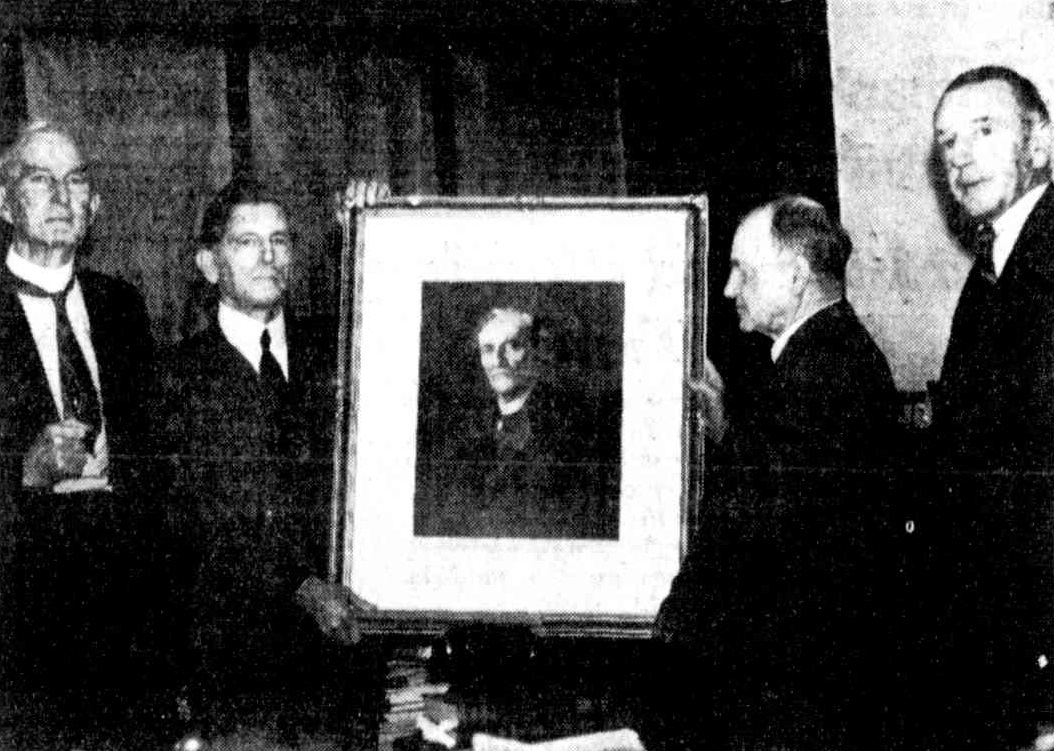
In the above picture Mr. L. A. Meston is seen handing the portrait of his late father to the Chief Justice, Sir James Blair, chairman of trustees of the Art Gallery. Behind Mr. Meston is Mr. E. Colclough, secretary of the Queensland National Art Gallery Trust, and behind Sir James Blair is Mr. W. A. Albers, art connoisseur.
THE portrait of the late Mr. Archibald Meston, who figured prominently in public life in Queensland for many years, now has been hung in the National Art Gallery at the Museum Building, Bowen Bark, and is on view there for the first time to-day. The portrait, which is a most faithful one, is a fine example of the work of Mr. B. E. Minns, the well-known Australian artist, who for 26 years practised outlines were made which resulted in a his art in London and Paris. splendid likeness.
A CLOSE FRIENDSHIP
The late Mr. Meston and Mr. Minns were very old and close friends. They met as young men and found much in common, not the least of which was their deep Interest in the vanishing aborigines, and they renewed that friendship upon Mr. Minns return.
Discussing the aborigines one day Mr. Meston said to his friend, "To understand the aborigines, Minns, you must know them." "Yes,' replied the artist, "and to know them is to love them."
As Chief Protector of Aborigines of Queensland for many years the late Mr. Meston was able to do a good deal to right the wrongs which had been inflicted upon the recent ancestors of these unfortunate people. It is safe to say that no man in Australia understood the Aborigines better than he.
A HAPPY INSPIRATION
It was a happy inspiration which prompted Mr. Minns to apply his art to the production of a portrait of his old friend. When the two were chatting together one day Mr. Minns said,"You know, Archie, I feel I should paint a portrait of you." Mr. Meston assented, and after a few sittings the preliminary outlines were made which resulted in a splendid likeness. The picture was completed in 1921, not long before Mr. Meston passed away.
The portrait is one of the best executed by Mr. Minns or any other Australian artist.
Mr. Minns himself was born at Inverell, N.S. Wales, 74 years ago.
BROUGHT TO QUEENSLAND.
The picture, no doubt, would have remained in Sydney but for the fact that Mr. Adolph W. Albers, connoisseur and promoter of Australian art, of Sydney, who makes periodical visits to Brisbane, prevailed on Mr, Minns to allow him to bring it up herefor sale. The result was that a subscription list was opened and the necessary 50 guineas was subscribed for its purchase. The Meston family gave generous help towards this, the idea being to present the picture to the local National Art Gallery.
The little ceremony took place, at the chambers of the Chief Justice (Sir James Blair), who is chairman of trustees of the National Art Gallery and President of the Queensland Art Fund. The other trustees— Messrs. F. C Gould, G. Comrie Smith— and Mr; E. Colclough, secretary of the trust, also were present, as Mr. L. A. Meston, a son of the late Mr. Meston, and Mr. Albers.
PORTRAIT OF LATE MR. A. MESTON (1936, November 5). The Telegraph (Brisbane, Qld. : 1872 - 1947), p. 10 (SECOND EDITION). Retrieved from http://nla.gov.au/nla.news-article180733474
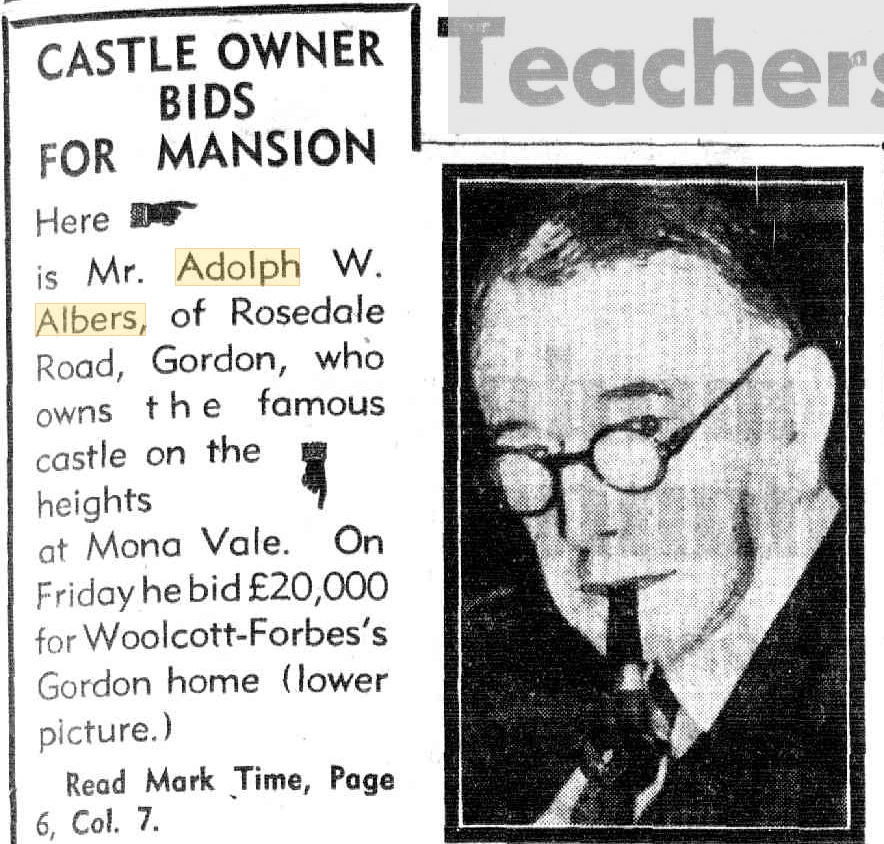
.jpg?timestamp=1539419840030)
.jpg?timestamp=1539419864478)
FEW SYDNEY HOMES WORTH £20,000 (1939, November 26). The Daily Telegraph (Sydney, NSW : 1931 - 1954), p. 7. Retrieved from http://nla.gov.au/nla.news-article247830007
ART AND MUSIC IN SCHOOLS.
Minister's Hopes.
A gift of 15 paintings by representative Australian artists was made to the Hornsby Girls' High School yesterday by Mr. Adolph W. Albers, making a total of about 60 pictures presented to the school by Mr. Albers during the past few years.
The Minister for Education. Mr. Evatt, who received the pictures on behalf of the department, thanked Mr. Albers for his practical efforts to encourage an appreciation of art in the schools. Mr. Evatt said he hoped to be able to have more time allocated in the curriculum for the study of art and music, which he regarded as a valuable part of education.
Mr. J. B. Shand, M.L.A., conveyed to Mr. Albers the thanks of the principal (Miss Slack) and staff for his generous action. The school, he added, had a fine art collection, which was begun during the time Miss Brewster was principal, and further augmented during Miss Slack's term.
Inspector R. C. Taylor presided, and there were also present Messrs. Will Ashton (Director of the National Art Gallery), and S. H. Smith (a former Director of Education).
ART AND MUSIC IN SCHOOLS. (1941, June 6). The Sydney Morning Herald (NSW : 1842 - 1954), p. 5. Retrieved from http://nla.gov.au/nla.news-article17760595
Is This Art?
As an artist and promoter of Australian art for over 40 years, may I suggest that the Government appoint a censorship on aft to safeguard the future sanity of the nation. Having visited the the Contemporary Art Exhibition at the Education Department's Gallery, I feel horrified at the display of works. The dignity, grace, composition, form quality romance and poetry so essential to stimulate the finer nature of mankind are replaced by vulgarity, indecency and coarseness. As a thing of beauty is a joy forever, a thing of horror is a stimulant to vice. Entering the exhibition room is like entering a parrot-house at the Zoo —everything is shrieking at the visitor.— Adolph W. Albers, Sydney. "Sun" Readers Say-- (1943, July 2). The Sun (Sydney, NSW : 1910 - 1954), p. 4 (LATE FINAL EXTRA). Retrieved from http://nla.gov.au/nla.news-article231730897
ART FOR AUCTION
Rare Sevres porcelain that once had a special sitting-room designed around it, valuable oil paintings, and exquisite ivories were among the art treasures sold when the collection of the late Sir Marcus Clark was auctioned in Sydney recently. ....
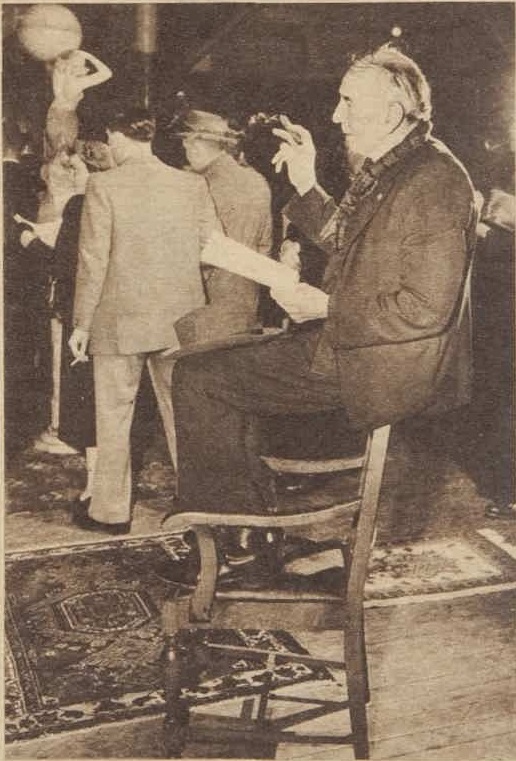
MR. ADOLPH W. ALBERS, who owns a small castle on Bungan Head, near Sydney, is often called "The Baron of Bungan Castle."
ART FOR AUCTION (1954, July 7). The Australian Women's Weekly (1933 - 1982), p. 13. Retrieved from http://nla.gov.au/nla.news-article4144985
The juvenile Nankeen Kestral, Falco cenchroides seen perching above is one of two that have been born this Spring and taken up residence at Bungan Castle with their parents.
John created the Flannel Flower for the above cornice himself - beautiful
A close up of John's Flannel Flower frieze work
Geoff and Collette Searl, on a rather windy afternoon atop Bungan Castle.